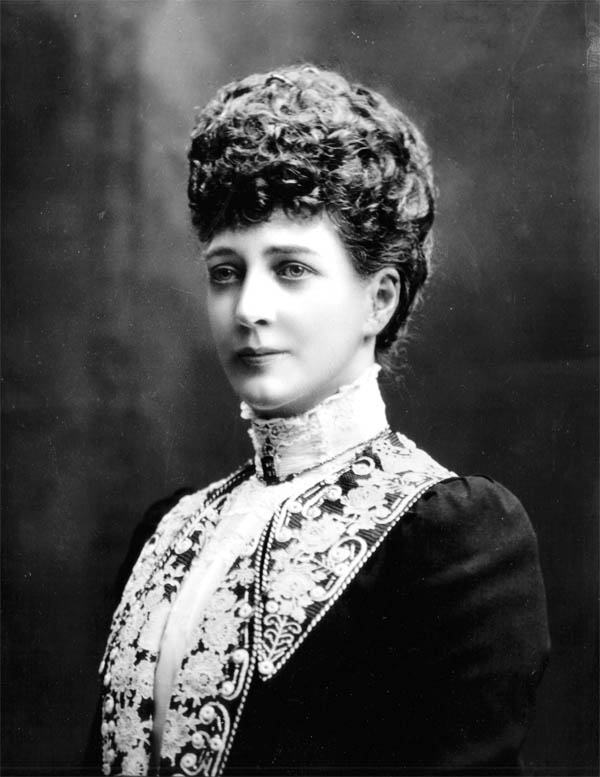 |
| HAAKON MOSVOLD LARSEN/AFP via Getty Images |
Did you know that the Norwegian royal family has British royal roots? Today we’ve got a closer look at one of their most important British royal jewelry inheritances: Queen Alexandra’s Turquoise Circlet.
 |
| Queen Alexandra, photographed at Sandringham in November 1902 (Wikimedia Commons) |
Though Queen Alexandra’s collection included numerous pieces set with colored gemstones, she generally sat for official portraits wearing diamonds and pearls. Because of this, we don’t have many photographs of her in her more colorful tiaras. We also don’t know for certain exactly when this unique diamond and turquoise tiara, with its Indian-inspired designs, came into Queen Alexandra’s collection, but a newspaper report from the Jersey Evening Post in December 1902 provides a possible provenance: “Last week we all united in congratulating our beautiful Queen on having attained her fifty-eighth birthday. The King’s birthday present to his Queen was a splendid diamond and turquoise tiara, turquoises being extraordinarily becoming to her fair hair and still lovely complexion.”
 |
| Queen Maud’s two turquoise tiaras: her diamond tiara, able to be worn in a turquoise setting, and Queen Alexandra’s Turquoise Circlet (Grand Ladies Site) |
When Queen Alexandra died in 1925, the turquoise tiara was inherited by her third daughter, Queen Maud of Norway. Queen Maud’s most prominent appearance in the turquoise tiara came four years later, when she wore it in March 1929 for a pre-wedding gala for her son, Crown Prince Olav of Norway, and his bride, Princess Märtha of Sweden, at the National Theater in Oslo.
The jewel was actually Queen Maud’s second turquoise tiara. In 1896, she had received a significant diamond tiara as a wedding present. That piece features a series of upright diamond “prong” elements, which could be switched out with a set of diamond and turquoise prongs. You can see the turquoise version of the tiara in this miniature portrait. At some point these diamond and turquoise prongs were repurposed in other pieces of jewelry. Indeed, the earrings that are now part of the Norwegian turquoise parure bear a significant resemblance to these diamond and turquoise prong elements.
 |
| Princess Astrid wears the turquoises for the British state banquet in Oslo, May 2001 (Fiona Hanson/PA Images/Alamy) |
The turquoise circlet is one of the Norwegian pieces that went through a thirty-year hibernation caused by a momentous war and the deaths of a queen and a crown princess. Queen Maud liked to travel back to her British homeland often to visit relatives, and during one of these visits in 1938, she died of a heart attack. She had brought her jewels with her on that particular trip, intending to have the pieces cleaned. But the jewels weren’t returned to Norway with the late queen’s body, and with the outbreak of World War II the following year, the jewels were stashed away in Windsor Castle for safekeeping.
It wasn’t until 1953 that the jewels were reclaimed by Maud’s son and daughter-in-law, Crown Prince Olav and Crown Princess Märtha, who brought them back to Norway following the coronation of Queen Elizabeth II. But then Märtha died unexpectedly in 1954, and Maud’s jewels were not brought out again until Olav’s son, the future King Harald V, married Sonja Haraldsen in 1968. Only then did Harald and his sisters divvy up the jewelry, and the turquoise circlet and its accompanying jewels went to Princess Astrid. In the image above, Princess Astrid (very appropriately) wears the turquoises during a British state visit to Oslo in May 2001.
Since then, the turquoises have been a key part of Princess Astrid’s gala jewelry. She wore them later the same year for one of the most important Norwegian royal events in a generation: the wedding of Crown Prince Haakon and Crown Princess Mette-Marit in Oslo in August 2001.
 |
| Princess Astrid wears the turquoises for the Dutch state banquet in Oslo, June 2010 (LISE ASERUD/AFP via Getty Images) |
In June 2010, she wore the turquoises for a banquet during the Dutch state visit to Oslo. You’ll note that Astrid generally wears the jewels with gowns in shades of blue, white, and gray.
 |
| HAAKON MOSVOLD LARSEN/AFP via Getty Images |
Princess Astrid has continued to wear her turquoises in recent years as well. In May 2017, she donned them for a major gala at the royal palace in Oslo celebrating the 80th birthdays of her brother, King Harald V, and her sister-in-law, Queen Sonja.
 |
| Sven Gj. Gjeruldsen / the Royal Court |
And a few months earlier, in February 2017, she wore them for official portraits to mark her own 85th birthday. This is a close-up from one of those images. In the full photograph, which you can see here, she stands between portraits of her parents, King Olav V and Crown Princess Märtha. The paintings and jewels combine to tell the story of Astrid’s royal heritage. She wears a bangle set with the badge of the Royal Order of Victoria and Albert, which honors her British royal great-great-grandparents. (She has since given the badge to her great-niece, Princess Ingrid Alexandra.) Astrid’s tiara was likely a gift from her great-grandfather, King Edward VII, to her great-grandmother, Queen Alexandra; it was later inherited by her grandmother, Queen Maud. Add in the portraits of her royal parents, and you have an entire genealogy offered in art and jewels.
Given the historical significance of the tiara, it should come as no surprise that Princess Astrid has planned for it to stay with the family. She has shared with her biographer, Trond Noren Isaksen, that the tiara will return to the Norwegian royal vaults (along with the Vasa Tiara) one day after her passing — hopefully far in the future.
Leave a Reply